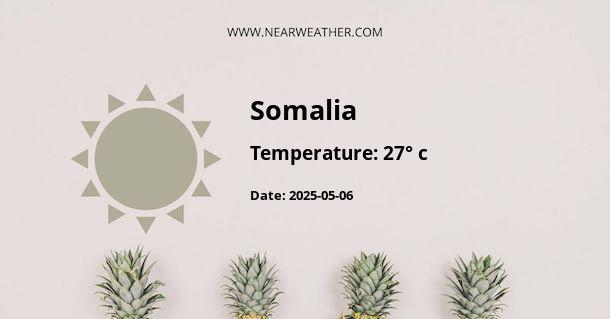Overview
Somalia, officially known as the Federal Republic of Somalia, is located in the Horn of Africa. Its climate is mainly hot and dry, with two main seasons; a dry season (Jilal) and a wet season (Gu). Its geographical location along the Equator and proximity to the Indian Ocean significantly influences its weather.
Climate Zones
Somalia's climate varies by region with four primary climate zones:
- The coastal area is influenced by the warm currents of the Indian Ocean and has a hot, humid climate.
- The North Western region experiences semi-desert climate with very hot temperatures and sparse rainfall.
- The South Western region experiences equatorial climate marked by high rainfall and moderate temperatures.
- The Central region has a desert climate characterized by high temperatures and minimal rainfall.
Temperature
Throughout the year, temperatures in Somalia range from 20°C (68°F) to 40°C (104°F). The coastal regions are usually warmer, with temperatures averaging around 28°C (82°F) annually, and can reach up to 45°C (113°F) during the dry season.
According to data from the World Bank, the average temperature in Somalia has slightly increased over the past few decades, a trend that aligns with global patterns of climate change.
Rainfall and Seasons
Somalia experiences two rainy seasons: Gu (April to June) and Dayr (October to November), and two dry seasons: Jilal (December to March) and Hagaa (July to September). However, rainfall is often unpredictable and varies by region.
Weather Patterns and Climatic Events
Due to its geographical location and climate, Somalia is prone to extreme weather events such as droughts and floods. These events often lead to humanitarian crises, affecting agricultural production and access to clean water. The increasing frequency and intensity of these events is linked to climate change.
Climate Change and Its Impact
As a result of climate change, Somalia has experienced an increase in average temperatures, changes in rainfall patterns, and increased frequency and intensity of droughts and floods. These changes have significant implications for the livelihoods of the Somali people, most of whom rely on agriculture and livestock for their survival.
Temperature and Rainfall Chart
The following chart provides a visual representation of the average monthly temperatures and rainfall in Somalia:
Month | Average Temperature (°C) | Average Rainfall (mm) ---------------------------------------------------------------- January | 27 | 8 February | 27 | 9 March | 29 | 20 April | 30 | 58 May | 31 | 39 June | 30 | 17 July | 29 | 8 August | 28 | 9 September | 29 | 10 October | 29 | 14 November | 28 | 23 December | 27 | 14
Conclusion
In conclusion, Somalia's climate is largely arid, with significant variations in temperature and rainfall across its different regions. The country's weather patterns are heavily influenced by its geographical location and are increasingly being affected by climate change. Understanding these climate patterns and their implications is crucial for planning and implementing effective climate change adaptation strategies in Somalia.
A - Somalia's Latitude is 6.000000 & Longitude is 48.000000.
A - Weather in Somalia is 26° today.
A - Climate Conditions in Somalia shows clear sky today.
A - Humidity in Somalia is 50% today.
A - Wind speed in Somalia is 33.62 km/h, flowing at 84° wind direction. today.
